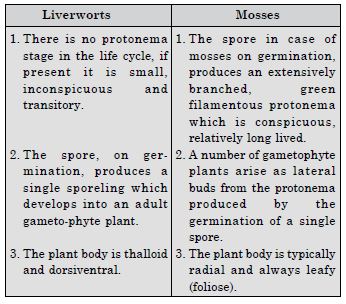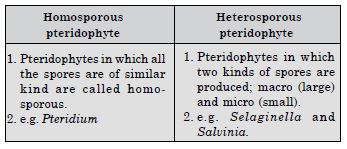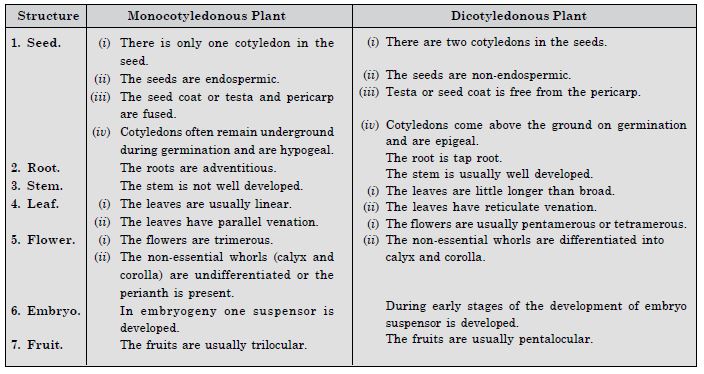Aasoka offers free NCERT Solutions which covers the latest CBSE syllabus for students of Class 11. This aid them to understand the concepts better which enhances their exam performance. Students who are on the lookout for top-quality educational resources can access the latest NCERT Solution for Class 11. The solutions are the ultimate resources that will help students in the preparation for competitive exams like JEE and NEET.
The Class 11 Biology chapter “Plant Kingdom” teach concepts such as distinguishing features of Bryophytes, Angiosperms, Algae, Gymnosperms, Plant Life Cycle, Pteridophytes, and Alternation of Generations; Kingdom Plantae (Plant Kingdom), classification of plants into various groups, etc.
Question 1:
What are the basis of classification of algae ?
Answer:
Algae are classified on the basis of following features : (i) Colour of thalli i.e. plant pigments (ii) storage product (iii) chemical nature of cell wall (iv) flagellation and (v) cellular organisation.
Question 2:
When and where does reduction division take place in life cycle of a liverwort, a moss, a fern, a gymnosperm and an angiosperm ?
Answer:
In a liverwort e.g. Marchantia, a diploid zygote formed by fusion of antherozoid and egg, gives rise to a sporogonium. This sporogonium undergoes meiosis to form haploid spores.
In case of mosses e.g. Funaria, the diploid zygote develops into the sporophyte containing sporogonium that has a spore sac. The diploid spore mother cells of spore sac divide by meiosis and form a large number of haploid spores.
In pteridophytes i.e. ferns, the dominant phase is the sporophytic plant body that bear leaves. The leaves bear sporangium. The sporangia produce spores by meiosis in spore mother cells.
In gymnosperms, reduction division occur in microsporophyll and mega-sporophyll which give rise to microspore and ovule respectively by meiosis.
In angiospermic plant, meiosis occur in male and female parts. In the male part i.e. the stamen, meiosis produces pollen grains in the anther. The pollen grains act as the male gamete. In the female part called carpel, embryo sac is formed as a result of meiosis of ovules in the ovary.
Question 3:
Name three groups of plants that bear archegonia. Briefly describe the life cycle of any one of them.
Answer:
Name three groups of plants that bear archegonia. Briefly describe the life cycle of any one of them.
- Main plant body is a sporophyte differentiated into rhizome, roots and compound leaves called fronds.
- Asexual reproduction takes place by means of sporangia which occur in group called sorus.
- Spores on germination give rise to heart-shaped gametophyte called prothallus.
- Prothallus is monoecious with archegonia present in apical cushion and antheridia in rhizoidal region.
- Sperm and egg on fertilization give rise to oospore (2n).
- Oospore develops into young sporophyte.
Thus in life cycle of a fern there is regular alternation of sporophytic and gametophytic generations. This process is called alternation of generations.
Question 4:
Mention the ploidy of the following : protonemal cell of a moss; primary endosperm nucleus in dicot, leaf cell of a moss; prothallus cell of a fern, gemma cell in Marchantia; meristem cell of monocot, ovum of a liverwort, and zygote of a fern.
Answer:
- Protonemal cell of a moss : Haploid (n)
- Primary endosperm nucleus in dicot : Triploid (3n
- Leaf cell of a moss : Haploid (n)
- Prothallus cell of a fern : Haploid (n)
- Gemma cell in Marchantia : Haploid (n)
- Meristem cells of monocot : Diploid (2n)
- Ovum of a liverwort : Haploid (n)
- Zygote of a fern : Diploid (2n)
Question 5:
Write a note on economic importance of algae and gymnosperms.
Answer:
Economic importance of algae
Algae are useful to man in a variety of ways.
- CO2 fixation. At least a half of the total carbon dioxide fixation on earth is carried out by algae through photosynthesis.
- Increase level of O2. Being photosynthetic, they increase the level of dissolved oxygen in their immediate environment.
- Producers of energy rich compounds. They are of paramount importance as primary producers of energy-rich compounds which form the basis of the food cycles of all aquatic animals.
- Used as food. Many species of Porphyra, Laminaria and Sargassum are among the 70 species of marine algae used as food.
- Production of hydrocolloids. Certain marine brown and red algae produce large amounts of hydrocolloids (water holding substances) e.g. algin (of brown algae) and carragenin (of red algae) are used commercially.
- Formation of nutritive medium. Agar, one of the commercial products obtained from Gelidium and Gracilaria are used to grow microbes and in preparation of ice-creams and jellies.
- Food supplements. Chlorella and Spirullina are unicellular algae, rich in proteins and are used as food supplements even by space travellers.
Economic importance of gymnosperms
- Edible Seeds. Seeds of Pinus gerardiana are edible. They are eaten after roasting.
- Timber. Gymnosperms are source of timber. Gymnosperms possess softwood. The same is used in preparation of light furniture, plywood, packing cases, match sticks, railway sleepers, etc.
- Paper. A number of gymnosperm woods are used in the manufacture of paper. They include Picea, Pinus, Larix and Abies.
- Fibre Boards. Needles of Pinus and other conifers are used in making fibre boards that are used in making packing cases.
- Linoleum. Saw dust is employed in making linoleum and plastics.
- Resin. Resin is a semifluid secreted by special tubes which contains terpenes, resin acids and esters. It solidifies on exposure to air.
- Ephedrine. Drug ephedrine is obtained from Ephedra, a gymnosperm. The drug is used in curing respiratory ailments, including asthma.
Question 6:
Both gymnosperms and angiosperms bear seeds. But, then why are they classified separately ?
Answer:
Both gymnosperms and angiosperms bear seeds. They are classified separately due to the following reasons :
- The Gymnosperms bear naked seeds whereas the angiosperms bear covered seeds.
- Gymnosperms are comparatively more ancient than angiosperms in evolutionary terms.
- Gymnosperms do not bear flowers but angiosperms are flowering plants.
- In gymnosperms wood is non-porous (vessels absent) whereas in angiosperms wood is porous (vessels present).
Question 7:
What is heterospory ? Briefly comment on its significance. Give two examples.
Answer:
Certain plants give rise to two kinds of spores, macro (large) and micro (small) spores. This condition is called heterospory usually the megaspore gives rise to female gametophyte and microspore gives rise to male gametophyte.
Significance. Heterospory leads to origin of seed habits.
e.g. Selaginella and Salvinia.
Question 8:
Explain briefly the following terms with suitable example :
- protonema
- antheridium
- archegonium
- diplontic
- sporophyll
- isogamy.
Answer:
(i) Protonema. In gametophytic phase of moss the first stage is the protonema which develops directly from a spore. It is a creeping, green, branched and frequently filamentous stage.
e.g. Funaria.
(ii) Antheridium
- It is the male sex organ.
- Antheridium is rounded or club-shaped in outline.
- The whole antheridium is fertile.
- An antheridium consists of a jacket and a mass of androcytes or sperm mother cells.
- An antheridium produces a large number of male gametes or spermatozoids.
- Antheridium occurs in bryophytes and pteridophytes.
(iii) Archegonium
- It is the female sex organ.
- It is flask-shaped in outline.
- Archegonium has a tubular sterile neck and a broader fertile venter.
- An archegonium is made of neck having lid cells, neck cells and neck canal cells, venter made of venter wall, venter canal cells and an egg or oosphere.
- Archegonium encloses a single female gamete or oosphere.
- Archegonium is found in bryophytes, pteridophytes and gymnosperms.
(iv) Diplontic Life Cycle. Cases where in the diploid sporophyte is the dominant, photosynthetic independent phases of the plant is called diplontic life cycle. It occurs in gymnosperms and angiosperms. (Refer Fig. 3.2).
(v) Sporophyll. They are not exactly leaf-like but they are modified specialized structures called sporophylls and they are of two kinds, microsporophylls and megasporophylls. Micro- sporophylls are clustered thus forming cone shaped structures called strobilus. Seeds are attached on the surface of cone.
(vi) Isogamy. Type of fusion of gametes when both the gametes are similar in size and morphology is called isogamy.
e.g. Chlamydomonas.
Question 9:
Differentiate between the following :
- liverworts and moss
- homosporous and heteros- porous pteridophyte
- syngamy and triple fusion.
Answer:
- Differences between liverworts and mosses
- Differences between homosporous and heterosporous pteridophytes
- Differences between syngamy and triple fusion
Question 10:
How would you distinguish monocots and dicots on the basis of three main characters ?
Answer:
Differences between monocotyledonous and dicotyledonous Plants
Question 11:
Matching type question.
- Chlamydomonas
- Cycas
- Selaginella
- Sphagnum
Answer:
1. (c) 2. (d) 3. (b) 4. (a)
Question 12:
Write the general characters, classification and examples of gymnosperms.
Answer:
General Features of Gymnosperms
- Gymnosperms are the most primitive seed bearing plants.
- These are represented by large, tall woody trees.
- Most of the plants are evergreen.
- In the life cycle, main plant is sporophytic generation and it dominates.
- Leaves are of two types—foliar and scales.
- Branches are of two types—dwarf shoot and long shoots.
- Reproductive structures are cones or strobili i.e. male cones and female cones.
- Ovules are present.
- Water is not essential for fertilization.
- Seeds are naked, not covered by ovary wall.
- They show polyembryony.
Classification and examples: Refer to Basics and Basis.





